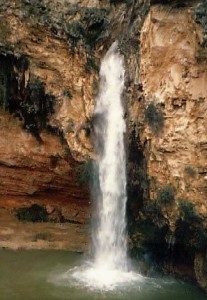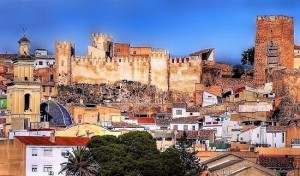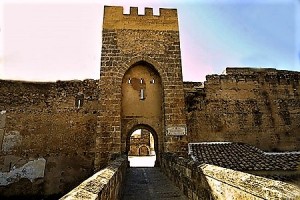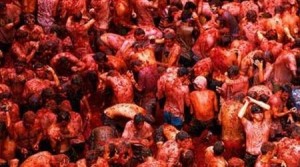Buñol: The Border Land
 Buñol is a charming village close to Valencia, famous all around the world for the event known as “La Tomatina”(tomato festival), his most spectacular and well known party … but Buñol is something more!!!
Buñol is a charming village close to Valencia, famous all around the world for the event known as “La Tomatina”(tomato festival), his most spectacular and well known party … but Buñol is something more!!!
Located 40 km far from Valencia by the westwards, the municipality belongs to the region of La Hoya de Buñol, and has a peculiar geographical location (347 m above sea level) by which ravines, rivers, fountains, springs, etc. are conforming a unique landscape, highlighting in La Cueva del Turche (geological unit formed by a cascade of 20 meters high).
Buñol has its roots in ancient times, different cultures inhabited the area (Prehistoric, Bronze, Iberian and Roman), during Roman and Visigoth period there was a village they called Bullion (boiling), but it wasn´t until the Islamic period (11thc.) when the the foundation of the town happened, with the construction of the first castle and the settlement of the population in the surroundings.
Buñol and all their region were joined at the Kingdom of Valencia in the middle of the 13th c. the villa was donated to Don Rodrigo de Lizana in 1238, forming the border between Valencia and Castilla. In 1279 Rodrigo de Lizana don ated it to the Order of the Hospital, which not liked King James I; so the village returned to the monarchy, who gave with the whole region to his bastard Pedro Fernandez de Hijar. From 1304-1415 passed from hand to hand among the members of the Crown of Aragon until the death of Martin I, step by the Antequera´s Ferdinand I and Alfonso V which sold it to Berenguer Mercader who founded the Barony of La Hoya Buñol … “possessed Mercader peoples of Buñol, Yátova, Seven Waters, Macastre and Alborache and already entered years, solved in its last testament, granted on June 30, 1467, the foundation of the bond of Barony of La Hoya de Buñol “... Thus, the Mercader Family, was linked to La Hoya de Buñol until 1836, when the Lordship finally returned to the Crown.
ated it to the Order of the Hospital, which not liked King James I; so the village returned to the monarchy, who gave with the whole region to his bastard Pedro Fernandez de Hijar. From 1304-1415 passed from hand to hand among the members of the Crown of Aragon until the death of Martin I, step by the Antequera´s Ferdinand I and Alfonso V which sold it to Berenguer Mercader who founded the Barony of La Hoya Buñol … “possessed Mercader peoples of Buñol, Yátova, Seven Waters, Macastre and Alborache and already entered years, solved in its last testament, granted on June 30, 1467, the foundation of the bond of Barony of La Hoya de Buñol “... Thus, the Mercader Family, was linked to La Hoya de Buñol until 1836, when the Lordship finally returned to the Crown.
During mid-nineteenth century was produced in the term of Buñol wheat, barley, oats, corn, silk, wine, oil, legumes, fruits and vegetables; had sheep and goats, as well as paper mills, flour mills and two fulling; communications had benefited the region with the construction of the main road from Madrid to Valencia and the railroad.  But in 1906 came phylloxera ending the economic rise and production. In April 1917 the Compañia Valenciana de Cementos (Valencia´s Company Cement) bought a small local cement plant, which was modernized and increased the scale of production until today. During the Spanish Civil War, despite being a focus republican and anarchist ideas, was under relatively calm and there were no violent crimes or abuses against persons or property. In the seventies 75% of its workforce was dedicated to the paper and cement industries, but with the economic crisis of the late twentieth century Buñol reoriented towards new sectors such as Food Process and Tourism based on Culture, Environment and Heritage.
But in 1906 came phylloxera ending the economic rise and production. In April 1917 the Compañia Valenciana de Cementos (Valencia´s Company Cement) bought a small local cement plant, which was modernized and increased the scale of production until today. During the Spanish Civil War, despite being a focus republican and anarchist ideas, was under relatively calm and there were no violent crimes or abuses against persons or property. In the seventies 75% of its workforce was dedicated to the paper and cement industries, but with the economic crisis of the late twentieth century Buñol reoriented towards new sectors such as Food Process and Tourism based on Culture, Environment and Heritage.
Today Buñol is a highly recommended place to be visited, with an old town where monuments such as the Castle, dating f rom 13th c. and that consists in two campuses: The North section as military compound and the South area for the residential use of the Lords of Buñol, where is located the 14th c. Mercader´s Palace, which now houses the Archaeological Museum. The Church of the Saviour which houses the Ethnological Museum and where the pantheon of the Counts of Buñol was. The Parish Church of San Pedro Apostol. St. Louis Park where is the Hermitage of San Luis Beltran. The Galán Mill an example of pre-industrial heritage refurbished as a library. The Hostel Inn, former horse inn 17th c., which retains its rustic style and today still remains in Inn House.
rom 13th c. and that consists in two campuses: The North section as military compound and the South area for the residential use of the Lords of Buñol, where is located the 14th c. Mercader´s Palace, which now houses the Archaeological Museum. The Church of the Saviour which houses the Ethnological Museum and where the pantheon of the Counts of Buñol was. The Parish Church of San Pedro Apostol. St. Louis Park where is the Hermitage of San Luis Beltran. The Galán Mill an example of pre-industrial heritage refurbished as a library. The Hostel Inn, former horse inn 17th c., which retains its rustic style and today still remains in Inn House.
Famous is the local cuisine with typical rice dishes, ham and chicken breast sandwiches, the “ajoarriero” an d the panning fruit. The Festivals are during the last week of the month of August with many different activities, among which the best well known event is La Tomatina (last Wednesday of August). http://latomatina.info/la-tomatina/
d the panning fruit. The Festivals are during the last week of the month of August with many different activities, among which the best well known event is La Tomatina (last Wednesday of August). http://latomatina.info/la-tomatina/
© FernandoC.
 |
 |
 |
|---|


